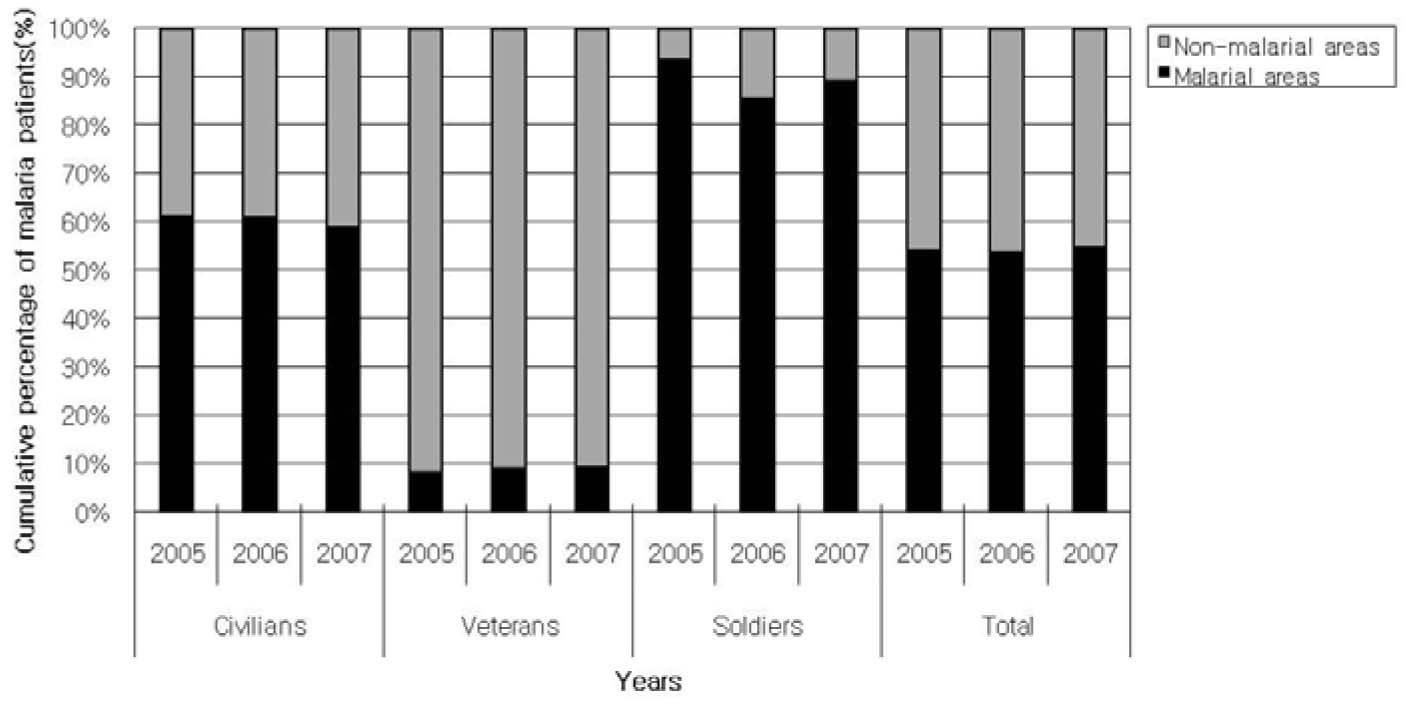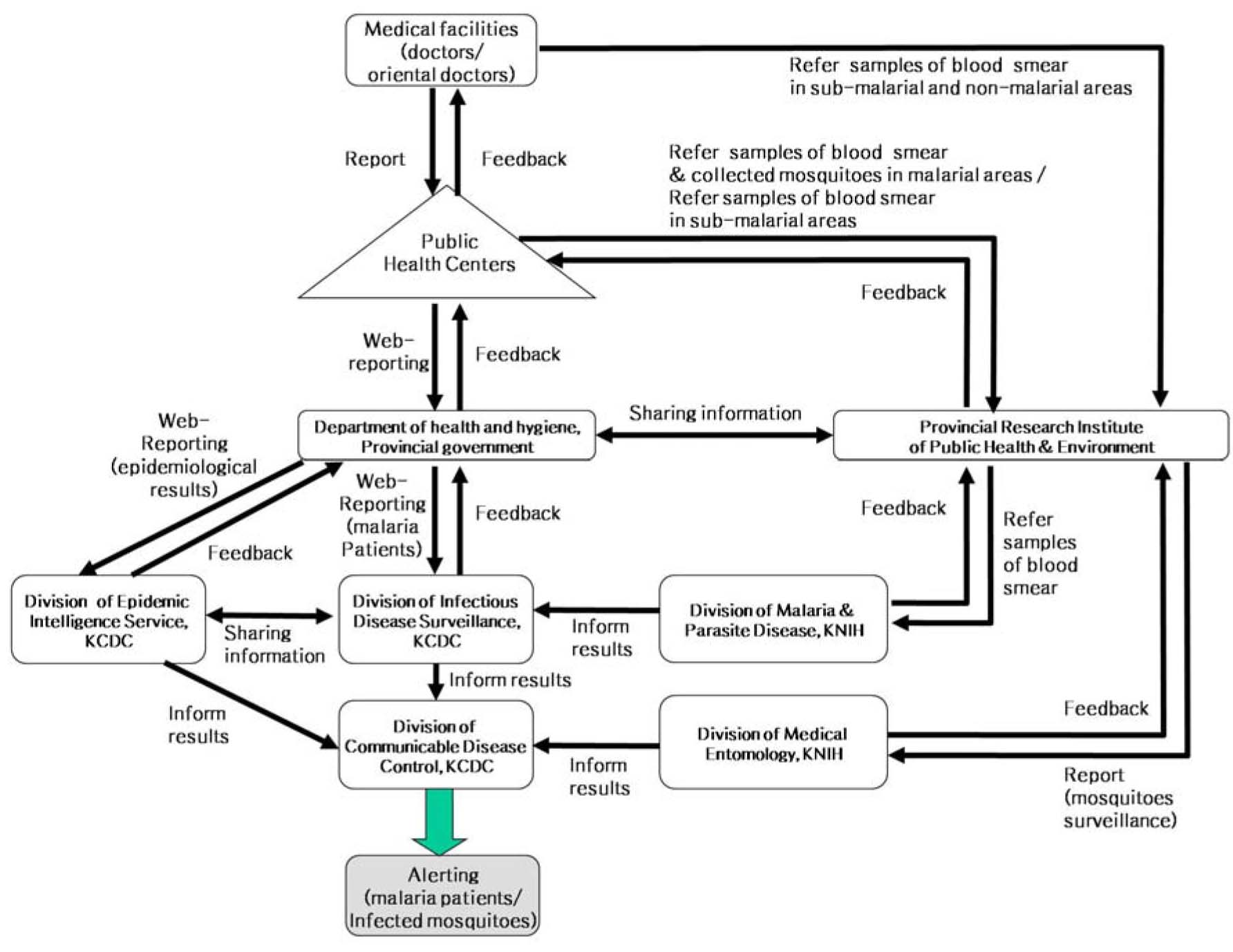Infect Chemother.
2009 Feb;41(1):42-53. 10.3947/ic.2009.41.1.42.
Evaluation of the Current Status of Malaria Elimination Project in the Republic of Korea and Suggestion for Improvement of Its Efficacy
- Affiliations
-
- 1Department of Microbiology, Gachon Medical School, Incheon, Korea.
- 2Department of Preventive Medicine, Gachon Medical School, Incheon, Korea.
- 3Health Policy Division, Ministry of National Defense, Seoul, Korea.
- 4Department of Internal Medicine, Kangbuk Samsung Hospital, Sungkyunkwan University School of Medicine, Seoul, Korea. jsodk@gachon.ac.kr
- KMID: 2170248
- DOI: http://doi.org/10.3947/ic.2009.41.1.42
Abstract
-
BACKGROUND: Vivax malaria had spread rapidly in areas adjacent to the Demilitarized Zone to reach more than 4,000 cases in 2000 in the Republic of Korea (ROK). After year 2000, annual cases decreased rapidly to reach less than 1,000 cases in 2004. However, the number increased again since 2005. Epidemiological characteristics of vivax malaria in the ROK are different before and after 2000. This article was aimed to evaluate the current status of malaria elimination project in the ROK for providing suggestions for its improvement.
MATERIALS AND METHODS
We analyzed the total reported malaria cases during 2005 to 2007 and reviewed the record on the malaria eradication project performed by the authorizations including the Korea Center for Disease Control and Prevention.
RESULTS
During 2005 to 2007, 45% of all the vivax malaria occurred in patients living in the non-prevalent areas; the interval between first symptom onset and diagnosis was longer in the non-prevalent areas compared to that in the prevalent areas. Education and publicity on malaria has not been properly performed in the non-prevalent areas. The military didn't take part in the control of the malaria infected discharged soldiers, most of whom might have been infected with malaria during their military service.
CONCLUSION
For the efficient control of malaria and thus improving the effectiveness of the elimination project, education and publicity on malaria in the non-prevalent areas should be strengthened and cooperation between private and military sector regarding the ex-soldiers infected with malaria is essential. In addition, there should be bilateral communication among malaria-related teams within the Korea Centers for Disease Control and Prevention and also among all the malaria-related sectors. Furthermore, a common database on malaria patients and vector mosquitoes should be formed to grant access to all the malaria-related sectors. Improvement on report and surveillance system is also necessary.
MeSH Terms
Figure
Reference
-
1. Sinden R, Gilles H. Warrell D, Gilles H, editors. The malaria parasites. Essential malariology. 2002. 4th ed. London: Arnold;8.2. Sachs J, Malaney P. The economic and social burden of malaria. Nature. 2002. 415:680–685.
Article3. Jeon JH. Outline of acute infectious diseases in Korea. 1975. Seoul: Choishin-euihak;28–34.4. Hasegawa Y. Malaria in Korea. J Chosen Med Soc. 1913. 4:53–69.5. Hasegawa Y. On the malaria endemicity in Kangnung. area in Kangwon-do. Mansen No Ikai. 1926. 62:59–66.6. Kobayashi H. Review on malaria and Anopheles in Korea. J Chosen Med Soc. 1932. 22:107–111.7. Hale TR, Halpenny GW. Malaria in Korean veterans. Can Med Assoc J. 1953. 68:444–448.8. Hankey DD, Jones R Jr, Coatney GR, Alving AS, Coker WG, Garrison PL, Donovan WN. Korean vivax malaria I. Natural history and response to chloroquine. Am J Trop Med Hyg. 1953. 2:958–969.9. Alving AS, Hankey DD, Coatney GR, Jones R Jr, Coker WG, Garrison PL, Donovan WN. Korean vivax malaria II. Curative treatment with pamaquine and primaquine. Am J Trop Med Hyg. 1953. 2:970–976.10. Coatney GR, Alving AS, Jones R Jr, Hankey DD, Robinson DH, Garrison PL, Coker WG, Donovan WN, Di Lorenzo A, Marx RL, Simmons IH. Korean vivax malaria V. Cure of the infection by primaquine administered during long-term latency. Am J Trop Med Hyg. 1953. 2:985–988.11. Jones R Jr, Jackson LS, Di Lorenzo A, Marx RL, Levy BL, Kenny EC, Gilbert M, Johnston MN, Alving AS. Korean vivax malaria III. Curative effect and toxicity of primaquine in doses from 10 to 30 mg. daily. Am J Trop Med Hyg. 1953. 2:977–982.12. Ministry of Health and Society. Report of Malaria eradication project 1959-1962. 1963. Seoul: Ministry of Health Society.13. Park JW, Klein TA, Lee HC, Pacha LA, Ryu SH, Yeom JS, Moon SH, Kim TS, Chai JY, Oh MD, Choe KW. Vivax malaria: a continuing health threat to the Republic of Korea. Am J Trop Med Hyg. 2003. 69:159–167.
Article14. Moon JJ, Cho SY. Incidence patterns of vivax malaria in civilians residing in a high-risk county of Kyonggi-do (province), Republic of Korea. Korean J Parasitol. 2001. 39:293–299.
Article15. Yeom JS, Ryu SH, Oh S, Lee WJ, Kim TS, Kim KH, Kim YA, Ahn SY, Cha JE, Park JW. Status of Plasmodium vivax malaria in the Republic of Korea during 2001-2003. Am J Trop Med Hyg. 2005. 73:604–608.
Article16. Yeom JS, Kim TS, Oh S, Sim JB, Barn JS, Kim HJ, Kim YA, Ahn SY, Shin MY, Yoo JA, Park JW. Plasmodium vivax malaria in the Republic of Korea during 2004-2005: changing patterns of infection. Am J Trop Med Hyg. 2007. 76:865–868.
Article17. Yeom JS, Ryu SH, Oh S, Choi DH, Song KJ, Oh YH, Lee JH, Kim YA, Ahn SY, Yang HY, Cha JE, Park JW. Evaluation of anti-malarial effects of mass chemoprophylaxis in the Republic of Korea army. J Korean Med Sci. 2005. 20:707–712.
Article18. Korea Centers for Disease Control and Prevention. Annual report of malaria elimination project in 2006. 2006. Seoul: Korea Centers for Disease Control and Prevention.19. Korea Centers for Disease Control and Prevention. Guide for the control of infectious diseases. 2007. Seoul: Korea centers for disease control and prevention.
- Full Text Links
- Actions
-
Cited
- CITED
-
- Close
- Share
- Similar articles
-
- Current Situation of Re-emerging Malaria and Elimination Plan in Republic of Korea
- Status of Vivax Malaria in the Republic of Korea
- Status of Vivax Malaria in the Republic of Korea in 2001
- Status of Plasmodium vivax Malaria in the Republic of Korea after Reemergence
- Malaria Incidence of the Regions Adjacent to the Demilitarized Zone in the Democratic People's Republic of Korea, 2004–2016





